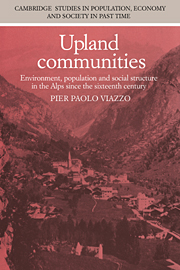 Upland Communities
Upland Communities Published online by Cambridge University Press: 13 October 2009
‘Traditional’ communities and tourist resorts
Most of what we know about contemporary population trends in the Alps comes from studies that geographers, and some economists, began to pursue in the late 1950s in the attempt to better understand a process of economic and demographic transformation which was rapidly taking imposing dimensions. Both these earlier studies and the subsequent literature are largely based on post-war census data, which have been used to work out helpful and at times sophisticated typologies. Different authors have relied on different classificatory and analytical criteria. Some have started from variations in the occupational structure, others have subdivided Alpine communities according to their rates of population growth or their altitude. On the whole, however, all these studies have proposed a sequence of types ranging from ‘traditional’ communities, where agriculture is still of primary significance and population is sharply declining, to the demographically much healthier tourist resorts, where increasing proportions of the inhabitants are engaged in service industries.
The striking contrast between these two extreme types of Alpine community was made almost brutally evident to me when, in the first months of my field research, I began to realize how different the situation of Alagna was from that of Rima and Rimella, the two other Walser colonies in the Sesia Valley. Rima, which had been a small village since its beginnings, was now completely abandoned during the winter and was inhabited by no more than a handful of people during the summer.
To save this book to your Kindle, first ensure [email protected] is added to your Approved Personal Document E-mail List under your Personal Document Settings on the Manage Your Content and Devices page of your Amazon account. Then enter the ‘name’ part of your Kindle email address below. Find out more about saving to your Kindle.
Note you can select to save to either the @free.kindle.com or @kindle.com variations. ‘@free.kindle.com’ emails are free but can only be saved to your device when it is connected to wi-fi. ‘@kindle.com’ emails can be delivered even when you are not connected to wi-fi, but note that service fees apply.
Find out more about the Kindle Personal Document Service.
To save content items to your account, please confirm that you agree to abide by our usage policies. If this is the first time you use this feature, you will be asked to authorise Cambridge Core to connect with your account. Find out more about saving content to Dropbox.
To save content items to your account, please confirm that you agree to abide by our usage policies. If this is the first time you use this feature, you will be asked to authorise Cambridge Core to connect with your account. Find out more about saving content to Google Drive.